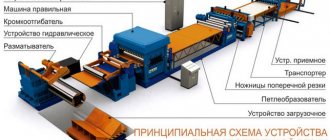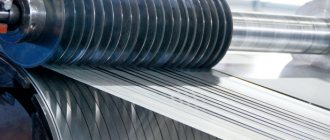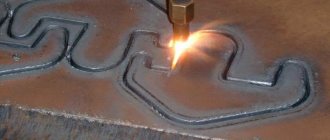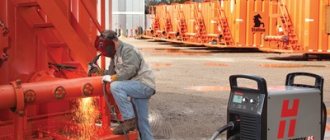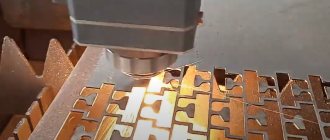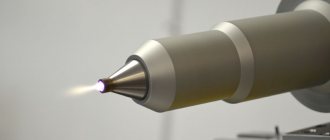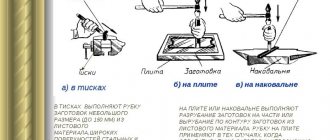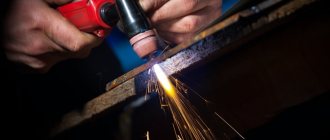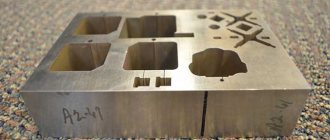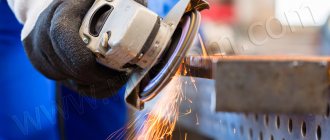The metalworking machine market offers a wide range of equipment that differs in operating principle and functionality. The most common solution for cutting metal is the hydraulic guillotine.
Powerful machines are designed for cutting sheet metal, and are characterized by high levels of accuracy and reliability. They are actively used in the manufacture of door leaves, profiled sheets, ventilation systems, drainage systems, and so on.
Metal cutting with a guillotine in Moscow
Guillotine equipment at metropolitan enterprises, including our workshop, rarely sits idle. The versatility of guillotine cutting is related to the size of rolled products that it can cut. The length of the blanks can reach two to three meters, width - 20 cm, and thickness - 12 cm. More than an impressive range. Traditionally it is believed that guillotine cutting is intended only for processing sheets. This is not entirely true: it all depends on the power of the device. There are machines for cutting metal with a guillotine in Moscow, which can equally easily separate workpieces with round or square sections.
Cutting with guillotine shears.
| Rice. 10.1. Kinematic diagram of guillotine shears 1 – electric motor; 2, 13 – flywheels; 3, 4, 5, 7 – gears; 6– coupling; 8 – upper knife; 9, 14 – bloodworms; 10 – eccentrics; 11 – sheet pressing support; 12 – crankshaft; 15 – lower knife. |
Guillotine shears are intended for straight cutting only.
The length of the knives is from 1.5 to 6 m. For the convenience of aligning the marking line on the sheet with the cutting line, guillotine shears have a checking ruler that is lowered onto the sheet using a handle or a special device that casts a narrow straight strip of light onto the sheet, coinciding with the cutting edges of the knives. When the guillotine shears are turned on, the upper knife is lowered, cutting, then raised and automatically held in the upper position using a clutch.
Some types of guillotine shears have a tiltable sheet support table. The table can be set at the required angle and thus ensure that the edges of the sheets are beveled.
The force that must be applied to cut sheets using scissors with inclined knives can be estimated using the formula:
,
where τ0 – shear resistance, kgf/mm2;
K – coefficient that takes into account the bluntness of the cutting edges of the knives, changes in the gap between the knives, uneven thickness and surface quality of the sheets (K=1.2-1.3);
λ – angle of inclination of the main cutting edge of the upper knife (λ=2-6°), degrees.
Cutting with press shears.
Press shears differ from guillotine shears by having shorter knives (from 250 to 600 mm).
Press shears with transverse arrangement of knives; provide straight cutting, as well as curved cutting with slight curvature of the cutting line and curved cutting.
One of the main disadvantages of press shears is the significant deformation of the sheets being cut, to the point that narrow strips curl into a spiral. Another disadvantage is the high labor intensity of cutting (2 times higher than when cutting with guillotine shears).
One of the varieties of shear presses are combined ones, which have knives for cutting sheets at one end of the frame, a piercing stamp at the other end, and knives for cutting profile steel in the middle of the frame.
Cutting with disc shears.
| Rice. 10.2. Diagram of disc shears: a) with parallel axes; b) with an inclined axis of the lower knife. |
Disc shears are two rotating cutting discs attached to a frame, the axes of which are located parallel to each other or at an angle.
The diameter of the knives ranges from 25 to 70 thicknesses of the sheets being cut, the thickness of the knives ranges from 20-80 mm. The grip angle of the knives is φ=10-14°, and their overlap is a=(0.2-0.3)S. Disc shears with an inclined knife axis have an inclination angle of θ=30-40°. The front angle of the knives is γ=1-1.5°. The cutting speed of disc shears is from 5 to 20 m/min. The cutting force with disc shears is determined by the formula:
.
Disc shears are mainly used for curved cutting of sheets.
It is not possible to automate the cutting process with circular shears, and therefore they cannot compete with automatic thermal cutting. In addition, a sheet cut using disc shears receives significant deformations and requires subsequent editing.
Guillotine for metal cutting: types and characteristics
Sheet metal cutting with a guillotine can be carried out on various types of machines. They are classified according to their operating principle. The only driving force in manual devices is not automation, but the hands of the master. An absolute plus of such guillotine shears is zero electricity costs. The disadvantages include a high probability of error due to the human factor and the inability to process rolled products with a thick cross-section: for example, when cutting steel sheets. Metal cutting services with a hydraulic guillotine already involve machine processing of workpieces: a device equipped with a hydraulic drive. The main advantage of such machines is the mass (serial) cutting of large batches of rolled products. Their performance is not satisfactory. The quietness of the operation is also considered a plus. The disadvantages of hydraulic machines include their bulkiness and heaviness. It is noisier, but also very productive, to chop metal using an electromechanical guillotine. In this case, guillotine cutting of metal is carried out due to the operation of an electric motor that drives the crank mechanism, which, in turn, transmits the driving force to the knife. Compared to hydraulic equipment, such a machine takes up very little space. When cutting metal with a pneumatic guillotine, the mechanism operates using compressed air. This is a very functional and expensive equipment with high productivity, so it is practically not found in private workshops, but large industries often give preference to it.
Hydraulic drive
The hydraulic drive in the case of metal guillotines can significantly increase their strength and operating capabilities. Main advantages of hydraulic equipment:
- high durability;
- quick start;
- smooth operation with easy speed control;
- the ability to reduce the weight and dimensions of the device without losing its operating efficiency;
- minimal risk of overload;
- high processing accuracy;
- low cost of maintenance and repair.
Differences between cutting metal using a guillotine and other cutting methods
Despite its simplicity and even seeming primitiveness, cutting metal on a guillotine in Moscow has its advantages over more “advanced” methods of metal processing - such as plasma, laser or waterjet cutting. It is energy-intensive, economical and, accordingly, cheap. No additional operations are performed on the metal either before or after the procedure: in particular, heating, which is dangerous for many materials. Consequently, it retains its physical and chemical properties, and after cutting it does not need to be cooled.
Cutting aluminum pipes (boxings)
Aluminum pipes and boxes are the most voluminous type of rolled aluminum products. The classification of such blanks is extensive. It is determined in accordance with GOSTs by shape, rolling method, wall thickness, and type of product.
To differentiate aluminum pipes by type of rolled material, the following GOST standards have been developed:
- 18475-82 and OST192096-83 for the production of cold-deformed pipes;
- 18482-79 – pressed pipes;
- 23697-79 – straight-seam welded pipe made of aluminum and alloys of this metal
The main difference between a pipe and a box is that a box is a pipe with a square or rectangular cross-section that has a lid and a base. That is, closed on both sides. Pipes and boxes are the most popular type of rolled aluminum. They are actively used in the construction of spaceships, sea and river vessels, cars, instruments, in the fields of architecture and the construction of buildings and structures for various purposes.
Cutting pipes and boxes using the guillotine method is the most effective method of cutting products. It performs precise cutting into parts of the required size with smooth edges. In this case, the metal does not heat up or deform and retains its technical characteristics.
Guillotine cutting - nuances of work
And yet, the guillotine was called that way not only because of its resemblance to its historical “relative”. Cutting metal with a guillotine in Moscow does not tolerate negligence and must be carried out in compliance with all safety standards. Before starting work, the master must inspect the machine, evaluate its performance, and remove all foreign objects from the work area. To avoid accidental cuts on the edges of the metal, it is better to wear gloves, especially when cutting sheets with a guillotine. And, of course, do not put your hands on the desktop, even if the mechanism is not currently functioning, but is connected to the network. Let us also remind you that the machine requires periodic cleaning and lubrication.
Automation
The ability to automate the metal cutting process opens up wide possibilities in metalworking. This allows you to optimize production processes, which for many companies means significant time savings and reduced costs per operation.
Among the most popular systems on the market that automatically support the operation of the guillotine, we can highlight the hydraulic table, which fully matches the specific type of element during processing, and increases the cutting accuracy, as well as holding the workpiece in the optimal position.
To automate guillotines, systems are often used that ensure the movement of processed products. Systems of this type allow spontaneous movement of the processed material outside the machine, using specialized drive belts.
Cost of cutting sheet metal on a guillotine
For a service such as metal cutting, the price remains favorable for the customer almost all year round.
And this despite the fact that he receives workpieces with high cut quality, obtained with minimal production waste. The cost of cutting metal with a guillotine and the price of the service largely depend on the serial production of the equipment - its ability to produce as many parts as possible in a limited period of time. Modern guillotines have complete order with serial production, which is what they prove. The second factor is the low costs of the contractor for cutting metal on a guillotine: the price for the customer only includes the cost of electricity to power the equipment.
In addition, by offering this mechanical operation, enterprises are more often ready to please consumers with good discounts. For metal cutting services using a guillotine, the price of one knife blow is much reduced if you need to make not a couple of dozen, but hundreds of such rubles.
Cutting aluminum sheets
GOST 21631–76 regulates the processing of different types of aluminum sheets. The scope of application of aluminum sheet depends on the characteristics of its production:
- Fuel storage tanks and welded containers are made of acid-resistant aluminum sheet. It is also used in aircraft and automotive industries. The main components of the alloy are aluminum and manganese, which provide high deformability of parts and good ductility;
- The technical sheet is used for insulation and finishing work. The main area of use is construction and repair work;
- The area of use of smooth corrugated sheets is finishing of premises for various purposes;
- Hygiene is the main characteristic of food grade aluminum sheet. It is used in the food industry. Production is carried out from pure aluminum, not subject to thermal effects, or its special alloys (A5M, A5N2, A5N)
In each of the listed areas of economic activity, tasks of cutting aluminum sheets up to 10 mm thick are performed. The guillotine cutting method allows you to obtain smooth edges of parts that do not require additional processing.
Equipment for cutting aluminum
Our company is equipped with modern high-performance machines with a guillotine mechanism and numerical software. Such equipment operates in accordance with a preset program, independently selects the optimal operating mode for a certain group of products, and performs metal cuts with pinpoint precision.
The human factor is reduced to a minimum - the operator only installs the program and monitors the operation of the machine. All operations are controlled by an intelligent system. Efficient operation is ensured and compliance with the specified parameters of the resulting products is guaranteed.

